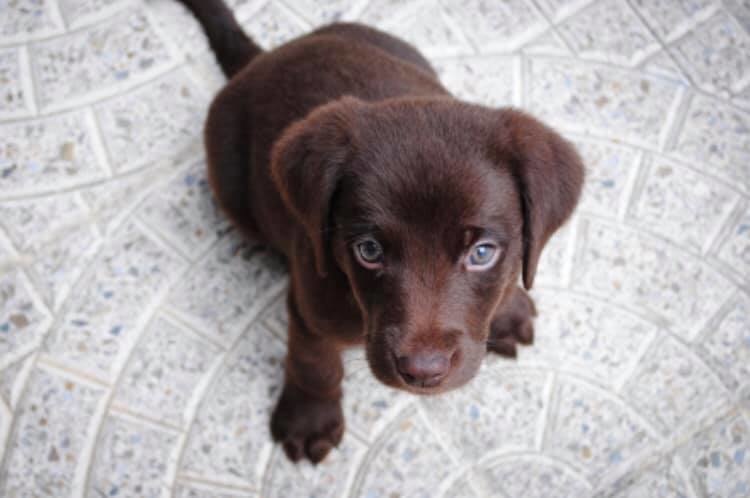How to toilet train your puppy by Anna Hope
Did you know that puppies learn by 2 weeks old to move away from their mother to go to the toilet? 2 weeks?! 😮
They're in the transitional stage and their senses are developing and they're becoming more aware of their own personality and surroundings. Moving away and doing the toilet in a different area to where you sleep or play, is technically, toilet training.
House training your puppy is always (and rightly so) at the top of the priority list!
It doesn't have to be difficult or stressful and it's something that shouldn't last for weeks or months. Some simple guidelines and tips can get you through this stage and get it under control, (so you can focus on everything else on the puppy training job list)!
👉 First thing to think about?
It's really important that you decide where you would like your puppy to go to the toilet. It sounds silly but so often everyone has a different opinion. Outside is usually where everyone agrees is the best place but is this the front or back garden, is there anywhere in particular you would prefer them to go? If you live in a flat or you have limited mobility, a litter tray indoors may be a good idea for you but we must ensure the training is done correctly. This is a personal decision but it’s one that must be made first.
👉 Why do puppies have accidents?
Simplest explanation is…they are puppies. They have small bladders which they cannot control yet, they don’t know where they should go and lots of other reasons too, including excitement.
Generally speaking, puppies will seek out an absorbent surface to wee on (such as carpets) because no one wants to be standing in their own urine so the chances of accidents happening on carpets or rugs is higher than other surfaces. This isn’t to say that puppies do not wee on hard surfaces such as concrete or laminate flooring, if they need to go, they need to go.
We also need to teach our puppies two things. We need to teach them where to go and also that they need to signal to us to get access to that place. Both of these in collaboration are how we toilet train a puppy.
Top tips for easy toilet training:
✔️ Routine! Get yourself in to a regular routine where you take your puppy outside for the opportunity to go. They are most likely to need to go first thing in the morning, after playing, sleeping, eating or after a visitor has arrived (or anything exciting has happened) and last thing at night. Where possible aim to get your puppy out as often as possible, every couple of hours and always give them the chance to get it right (go outside) rather than wait until they get it wrong and can’t hold it.
✔️ Be a good spotter of body language. Usual signs that they’re about to go will be sniffing the floor and circling. When you see these try to encourage them to go outside. It’s your job to learn your dog’s body language and their usual signs so you can give them as many opportunities to get it right as possible.
✔️ When they do go (in the right place) have a pee (or a poo) party! Woohoo! It’s the best thing to happen, they have gone in the right place. Give them lots of praise and fuss (it doesn’t have to be a treat). Your puppy will LOVE the celebration and why would they do it anywhere else? It’s also really important to only celebrate when they have completely finished. Avoid celebrating too early or you’ll interrupt your puppy mid flow and they’ll just finish it off inside.
✔️ Pick a ‘cue’ (a word we use to signal to our dog) which you can use regularly. ‘Go toilet’ is always a classic and just say this once when you are taking them out to have a try. With enough repetition of this you can then take this out with you on walks. It’s sometimes common for puppies to avoid going to the toilet when they’re on walks and they save it for when they get home. If you have a cue that they understand means go to the toilet then you can help them do this when you go out.
✔️ Avoid confusing signals. Avoid using anything such as puppy pads or newspaper to train your puppy to go on. It confusing for your pup! You are firstly training them to go on a pad indoors but then it’s not ok to do this and you want them to go outside. Keep it simple and stick with indoors = nope, outdoors = party time!
What to do if it doesn’t seem to be working yet:
💡 Make sure you are getting them out often. If your puppy goes outside and just plays, pop a lead on them and go out with them. Be boring and just use your cue and just don’t allow them to have playtime. Limit this to 10 minutes and if they haven’t been just bring them back in and try again later.
💡 If any accidents do happen make sure you clean them up thoroughly. You can purchase specific cleaning solutions or biological washing powder works too. You have to make sure the enzymes are cleaned away otherwise your puppy will be able to smell them and will go to the toilet on the same spot.
💡 Get rid of puppy pads or anything you’re using that might be confusing to them.
Things to remember as you progress 💖💖
- Your puppy is young, on their own (whereas they weren’t before) and they are in our world and they need reassurance and patience. Give them time to learn.
- NEVER punish your puppy for an accident. This includes shouting at them, tapping them, pushing their nose in it…. you get the picture. This is old and hugely outdated advice that originated from a time when dog training wasn’t well studied. It doesn’t give your puppy an opportunity to learn what you do want, it just teaches them that you are something to be feared. This just results in a hesitant and fearful puppy who will just go to the toilet where you can’t see it. Then what happens? They don’t go to the toilet on a walk (in front of you).
- If your puppy wees out of excitement then make sure greetings are as calm as possible and in areas that you are happy to accept accidents will happen.
- If your puppy is having an accident in the night then just set your alarm for the early hours and give them a chance to go out. Click their lead on, keep it boring and out you go. Once they’ve done it celebrate calmly and it’s back to bed.
Toilet training is all about routine, clear signals and as many opportunities to get it right as possible. Give them time and give them some support. If you get them in to a fab toileting routine from a young age, it’ll only get easier as they get older and you wont have to do as much as you do now.
If you do struggle or things just aren’t changing reach out to a qualified dog trainer and get some modern, helpful advice.
You’ll be amazed how often you talk about toilet habits when you have a puppy!
Fancy knowing how to train your dog FASTER & BETTER?
With accuracy and without confusion?
Grab my easy 5 minute guide HERE

